Overview
Chambers and valves of the heart
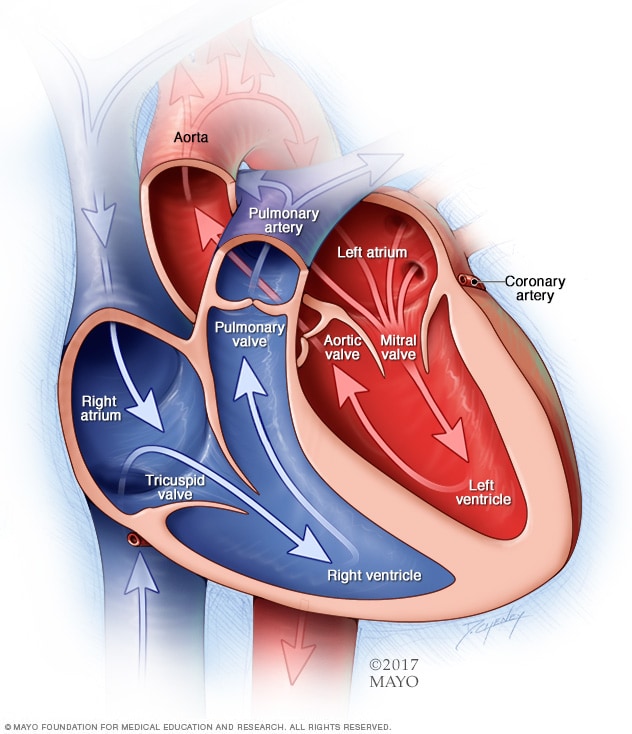
Chambers and valves of the heart
A typical heart has two upper and two lower chambers. The upper chambers, the right and left atria, receive incoming blood. The lower chambers, the more muscular right and left ventricles, pump blood out of the heart. The heart valves, which keep blood flowing in the right direction, are gates at the chamber openings.
Aortic valve repair and aortic valve replacement are procedures to treat a damaged or diseased aortic valve.
The aortic valve is one of four valves that control blood flow in the heart. It separates the lower left heart chamber (left ventricle) and the body's main artery (aorta).
When the heart squeezes (contracts), the aortic valve opens and lets blood flow from the left ventricle into the aorta. When the heart relaxes, the aortic valve closes to prevent blood from moving backward.
A diseased or damaged aortic valve can interfere with blood flow and force the heart to work harder to send blood to the rest of the body.
Aortic valve repair or aortic valve replacement can improve blood flow, reduce symptoms of heart valve disease and prolong life.
Products & Services
Types
Why it's done
Aortic valve regurgitation
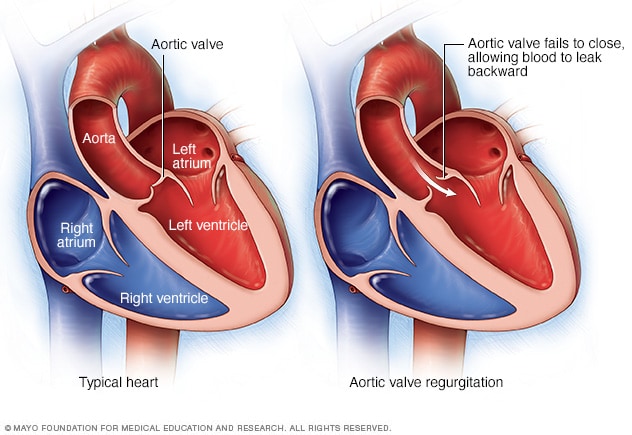
Aortic valve regurgitation
In aortic valve regurgitation, the aortic valve doesn't close properly, causing blood to leak backward into the lower left heart chamber (left ventricle).
Aortic valve stenosis

Aortic valve stenosis
Aortic valve stenosis is a thickening and narrowing of the valve between the heart's main pumping chamber and the body's main artery, called the aorta. The narrowing creates a smaller opening for blood to pass through. This reduces or blocks blood flow from the heart to the rest of the body. Typically the aortic valve has three cusps, called a tricuspid aortic valve. But some people are born with an aortic valve that has two cusps, a condition called bicuspid aortic valve.
Aortic valve repair and aortic valve replacement are done to treat aortic valve disease. Mild aortic valve disease without symptoms may only require frequent health checkups. But most aortic valve conditions are mechanical problems that eventually require surgery to reduce symptoms and the risk of complications, such as heart failure, heart attack, stroke or death due to sudden cardiac arrest.
Types of aortic valve disease that may require treatment with aortic valve repair or replacement include:
- Aortic valve regurgitation. Blood flows backward through the aortic valve into the heart's main pumping chamber (left ventricle). Aortic valve regurgitation may result from a leaky or dysfunctional valve. Any condition that damages the aortic valve can cause regurgitation. Sometimes, a baby is born with an irregularly shaped aortic valve (congenital heart defect) that leads to regurgitation.
- Aortic valve stenosis. The aortic valve is narrowed or blocked. It's hard for the valve to open properly. The heart must work harder to pump blood into the aorta. Aortic valve stenosis may be caused by a heart condition present at birth (congenital heart defect). An infection called rheumatic fever may lead to inflammation that damages the heart valve (rheumatic heart disease).
- Other aortic valve problems present at birth (congenital heart defects). Some babies may be born with an aortic valve that's missing a valve opening or that doesn't have enough tissue flaps (cusps). A congenital heart defect can also cause the valve to be the wrong size or shape.
Incisions in minimally invasive heart surgery and open-heart surgery

Incisions in minimally invasive heart surgery and open-heart surgery
In minimally invasive heart surgery, surgeons access the heart through small cuts on the right side of the chest, as shown in the top two images. In open-heart surgery, surgeons make a larger incision in the midline of the chest, as shown in the bottom image.
Related information
Transcatheter aortic valve replacement (TAVR)
The decision to repair or replace a damaged aortic valve depends on many things, including:
- The severity (stage) of aortic valve disease
- Age and overall health
- Whether surgery is needed to correct another valve or heart condition
In general, surgeons recommend valve repair when possible, as it lowers the risk of infection, saves the heart valve and may improve heart function. The best option depends on the specific aortic valve problem, as well as the expertise and experience of the health care team.
Aortic valve repair and aortic valve replacement may be done through traditional open-heart surgery, which involves a cut (incision) in the chest, or by using minimally invasive methods, which involve smaller incisions in the chest or a catheter inserted in the leg or chest (transcatheter aortic valve replacement, or TAVR).
Minimally invasive heart surgery may involve a shorter hospital stay, quicker recovery and less pain than traditional open-heart surgery.
What type of valve surgery you have depends on your individual situation. For example, some people with aortic valve disease may not be candidates for traditional open-heart surgery due to other health problems, such as lung or kidney disease, that would make the procedure too risky. Your health care provider will explain the benefits and risks of each option.
Risks
All surgeries have risks. Risks of aortic valve repair and replacement depend on your health, the type of procedure, and the expertise of the surgeons and other health care providers.
To reduce potential risks, aortic valve surgery should generally be done at a center with a multidisciplinary heart team that is experienced in such procedures and does many aortic valve surgeries.
Potential risks associated with aortic valve repair and aortic valve replacement surgery may include:
- Bleeding
- Blood clots
- Problem or failure of a replacement valve
- Heart rhythm problems (arrhythmias)
- Infection
- Stroke
- Death
How you prepare
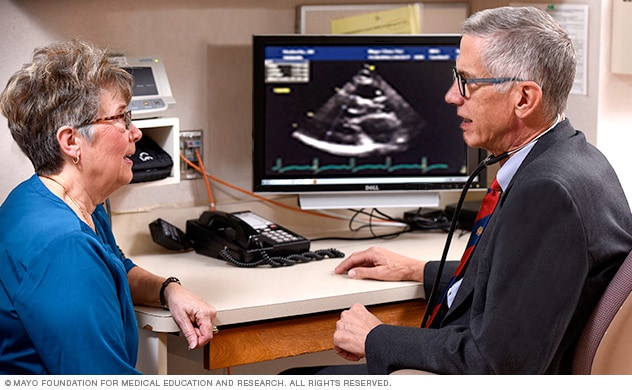 Aortic valve repair and replacement consultation at Mayo Clinic
Aortic valve repair and replacement consultation at Mayo Clinic
Your Mayo Clinic care providers will discuss any questions you might have about your aortic valve repair or aortic valve replacement procedure at Mayo Clinic.
Before surgery to have your aortic valve repaired or replaced, your health care providers will explain to you what to expect before, during and after the surgery and the potential risks of the surgery.
Before being admitted to the hospital for your heart valve surgery, talk to your caregivers about your upcoming hospital stay. Discuss any help you may need when you return home.
Don't hesitate to ask your care providers any questions you may have about the procedure.
Food and medications
Talk to your health care provider about:
- When or if you can take your regular medications before surgery
- When or if you should stop eating or drinking the night before surgery
Clothing and personal items
Your health care providers may recommend that you bring several items to the hospital including:
- A copy of your advance directive or living will
- A list of your medications
- Eyeglasses, hearing aids or dentures
- Items that may help you relax, such as portable music players or books
- Loosefitting, comfortable clothing
- Personal care items, such as a brush, a comb, shaving equipment and a toothbrush
During surgery, avoid wearing:
- Contact lenses
- Dentures
- Eyeglasses
- Jewelry
- Nail polish
What you can expect
Before the procedure
When you arrive for surgery, a care provider will insert an IV into your forearm or hand. Fluids and medicines can be given through the IV. A care provider may shave off any hair at the location where the procedure will take place.
For most valve repair and replacement procedures, you'll receive medications that put you in a sleep-like state (general anesthesia) so you won't feel any pain during the surgery.
You may be connected to a heart-lung bypass machine. The machine keeps blood moving through the body during the heart valve surgery.
During the procedure
Aortic valve repair
Aortic valve repair is usually done with open-heart surgery and by opening the chest bone (sternotomy). Surgeons wire the bone back together after the procedure to prevent movement and aid in healing.
Aortic valve repair procedures may involve several different types of repair, including:
- Inserting tissue to patch holes or tears in the flaps (perforated cusps)
- Adding support at the base or roots of the valve
- Separating valve cusps that have fused
- Reshaping or removing tissue to allow the valve to close more tightly
- Tightening or reinforcing the ring around the valve (annulus) by implanting an artificial ring (annuloplasty)
Minimally invasive aortic valve repair
If the aortic valve can't fully open due to aortic valve stenosis, a less invasive procedure called balloon valvuloplasty may be used to repair the valve. Minimally invasive heart valve surgery typically involves smaller incisions and a shorter hospital stay than traditional open-heart surgery.
During balloon valvuloplasty, a surgeon inserts a thin, hollow tube (catheter) into a blood vessel, usually in the groin, and threads it to the heart. A balloon on the tip of the catheter is inflated, which widens the narrowed valve.
Balloon valvuloplasty is often used to treat infants and children with aortic valve stenosis. However, the valve tends to narrow again in adults who have had the procedure, so it's usually only done in adults who are too ill for surgery or who are waiting for a valve replacement. You may need additional procedures to treat the narrowed valve over time.
Some replacement heart valves may begin to leak or not work as well over time. Surgery or a catheter procedure may be done to repair or plug a leaking replacement heart valve.
Mechanical heart valve replacement

Mechanical heart valve replacement
In a mechanical valve replacement, an artificial heart valve made of strong material replaces the damaged valve.
Biological valve replacement

Biological valve replacement
In a biological valve replacement, a valve made from cow, pig or human heart tissue replaces the damaged heart valve.
Transcatheter aortic valve replacement (TAVR)
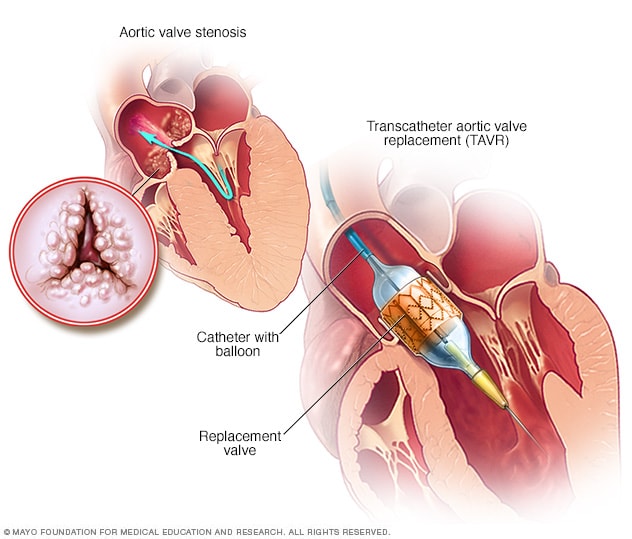
Transcatheter aortic valve replacement (TAVR)
Transcatheter aortic valve replacement is commonly called TAVR. It's done to replace a narrowed aortic valve, a condition called aortic valve stenosis. A doctor inserts a flexible tube called a catheter into a blood vessel and guides it into the heart. A replacement valve made of cow or pig tissue goes through the tube to the area of the aortic valve. A balloon on the catheter tip inflates to press the new valve into place. Some valves are self-expanding.
Aortic valve replacement
If the aortic valve can't be repaired, surgery may be needed to replace the valve. In this procedure, a surgeon removes the aortic valve and replaces it with a mechanical valve or a valve made from cow, pig or human heart tissue (biological tissue valve). Another type of biological tissue valve replacement that uses your own lung (pulmonary) valve is sometimes possible.
If you have a mechanical valve, you'll need to take blood-thinning medications for life to prevent blood clots. Biological valves often eventually need to be replaced, as they break down (degenerate) over time. Together, you and your health care providers should discuss the risks and benefits of each type of valve to choose the one that's best for you.
Aortic valve replacement may be done using open-heart surgery or minimally invasive methods, which involve smaller incisions than those used in open-heart surgery. Transcatheter aortic valve replacement (TAVR) is a type of minimally invasive aortic valve replacement. It is also sometimes called transcatheter aortic valve implantation (TAVI).
When minimally invasive aortic valve replacement is done by experienced surgeons and centers, the results are like those with traditional open-heart surgery.
After the procedure
After aortic valve repair or replacement, you may spend a day or more in the intensive care unit (ICU).
You'll be given fluids, nutrition and medications through intravenous (IV) lines. Other tubes will drain urine from your bladder and drain fluid and blood from your heart and chest. You may be given oxygen.
After your stay in the ICU, you'll be moved to a regular hospital room for several days. The time you spend in the ICU and hospital can vary, depending on your condition and procedure.
During your hospital stay, your care providers will:
- Watch for signs of infection in your incision sites
- Periodically check your blood pressure, breathing and heart rate
- Work with you to manage any pain you have after surgery
- Encourage you to walk regularly to gradually increase your activity and do breathing exercises as you recover
Recovery time depends on your procedure, overall health before the procedure and any complications.
Your health care provider may tell you to avoid driving a car or lifting anything heavier than 10 pounds for several weeks.
Results
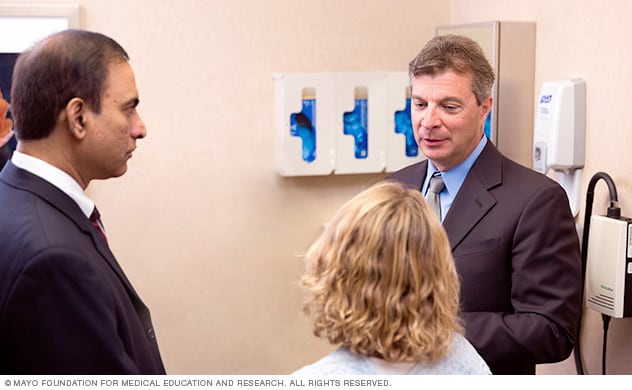 Aortic valve repair and replacement consultation at Mayo Clinic
Aortic valve repair and replacement consultation at Mayo Clinic
Your Mayo Clinic health care team will provide ongoing, coordinated care after aortic valve surgery.
After aortic valve repair or replacement surgery, your health care provider can tell you when you can return to daily activities, such as working, driving and exercise.
You'll typically need regular health checkups to monitor your heart condition and to check for complications, such as valve failure. Imaging tests may be done to make sure the aortic valve is working correctly.
After heart valve surgery, it's important to follow a heart-healthy lifestyle. Your health care provider may recommend these lifestyle changes:
- Getting regular exercise
- Controlling weight
- Eating a healthy diet
- Managing stress
- Not smoking
Your health care provider may also suggest enrolling in a program of education and exercise — called cardiac rehabilitation — to improve your overall health and help you recover after aortic valve surgery.
Clinical trials
Explore Mayo Clinic studies of tests and procedures to help prevent, detect, treat or manage conditions.
Feb. 02, 2024